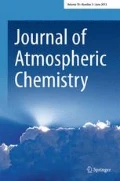Abstract
The latitudinal variation of the photolysis frequency of ozone to O(1D) atoms, J(O1D), was measured using a filter radiometer during the cruise ANT VII/1 of the research vessel Polarstern in September/October 1988. The J(O1D) noon values exhibited a maximum of 3.6×10-5 s-1 (2π sr) at the equator and decreased strongly towards higher latitudes. J(O1D) reached highest values for clean marine background air with low aerosol load and almost cloudless sky. The J(O1D) data, measured under these conditions and a temperature of 295 K, can be expressed by: % MathType!MTEF!2!1!+-% feaafiart1ev1aaatCvAUfeBSjuyZL2yd9gzLbvyNv2CaerbuLwBLn% hiov2DGi1BTfMBaeXatLxBI9gBaerbd9wDYLwzYbItLDharqqtubsr% 4rNCHbGeaGqiVu0Je9sqqrpepC0xbbL8F4rqqrFfpeea0xe9Lq-Jc9% vqaqpepm0xbba9pwe9Q8fs0-yqaqpepae9pg0FirpepeKkFr0xfr-x% fr-xb9adbaqaaeGaciGaaiaabeqaamaabaabaaGcbaGaamOsaiaacI% cacaqGpbWaaWbaaSqabeaaiiaacqWF8baFaaGccaqGebGaaeykaiaa% bccacqWF9aqpcaqGGaGaaeyzaiaabIhacaqGWbGaaeiiaiaabUhacq% GHsislcaaI4aGaaiOlaiaaicdacaaIYaGaeyOeI0IaaGioaiaac6ca% caaI4aGaaiiEaiaaigdacaaIWaWaaWbaaSqabeaacqGHsislcaaIZa% aaaOGaaeiiaiaabIhacaqGGaGaam4uaiabgUcaRiaaiodacaGGUaGa% aGinaiaacIhacaaIXaGaaGimamaaCaaaleqabaGaeyOeI0IaaGOnaa% aakiaadofadaahaaWcbeqaaiaaikdaaaGccaGG9bGaaeikaiaaboha% daahaaWcbeqaaiabgkHiTiaaigdaaaGccaGGPaaaaa!5EE9!\[J({\text{O}}^| {\text{D) }} = {\text{ exp \{ }} - 8.02 - 8.8x10^{ - 3} {\text{ x }}S + 3.4x10^{ - 6} S^2 \} {\text{(s}}^{ - 1} )\] where S represents the product of the overhead ozone column (DU) and the secant of the solar zenith angle. The meridional profile of the primary OH radical production rate P(OH) was calculated from the J(O1D) measurements and simultaneously recorded O3 and H2O mixing ratios. While the latitudinal distribution of J(O1D) and water vapour was nearly symmetric to the equator, high tropospheric ozone levels up to 40 ppb were observed in the Southern Hemisphere, SH, resulting in higher P(OH) in the SH.
Similar content being viewed by others
References
Behr, H. D., 1992, Net total and UV-B radiation at the sea surface, J. Atmos. Chem. 15, 299–314 (this issue).
Bahe, F. C., and Schurath, U., 1978, Measurement of O(1D) formation by ozone photolysis in the troposphere, Pageoph 116, 537–544.
Bahe, F. C., Marx, W. N., Schurath, U., and Röth, E. P., 1979, Determination of the absolute photolysis rate of ozone by sunlight, 297–1, at ground level, Atmos. Environ. 13, 1515–1522.
Blackburn, T. T., 1984, Solar photolysis of ozone to singlet D oxygen atoms, O1D, Dissertation thesis, University of Michigan.
Brauers, T., and Hofzumahaus, A., 1992, Latitudinal variation of measured NO2 photolysis frequencies over the Atlantic Ocean between 50° N and 30° S, J. Atmos. Chem. 15, 269–282 (this issue).
Chameides, W. L., and Tan, A., 1981, The two-dimensional diagnostic model for tropospheric OH: An uncertainty analysis, J. Geophys. Res. 86, 5209–5223.
Crutzen, P. J., 1974, Photochemical reactions initiated by and influencing ozone in unpolluted tropospheric air, Tellus 26, 47–57.
Demerjian, K. L., Schere, K. L., and Peterson, J. T., 1980, Theoretical estimates of actinic (spherically integrated) flux and photolytic rate constants of atmospheric species in the lower troposphere, in J. N., Pitts, R. L., Metcalf, and D., Grosjean (eds.), Advances in Environmental Science and Technology, Vol. 10, Wiley, New York, pp. 369–459.
DeMore, W. B., Sander, S. P., Golden, D. M., Molina, M. J., Hampson, R. F., Kurylo, M. J., Howard, C. J., and Ravishankara, A. R., 1990, Chemical kinetics and photochemical data for use in stratospheric modeling, No. 9, NASA, JPL-90-1 publication.
Dickerson, R. R., Stedman, D. H., Chameides, W. L., Crutzen, P. J., and Fishman, J., 1979, Actinometric measurements and theoretical calculations of J(O3), the rate of photolysis of ozone to O(1D), Geophys. Res. Lett. 6, 833–836. Correction in Geophys. Res. Lett. 7, 112.
Dickerson, R. R., Stedman, D. H., and Delany, A. C., 1982, Direct measurements of ozone and nitrogen dioxide photolysis rates in the troposphere, J. Geophys. Res. 87, 4933–4946.
Ehhalt, D. H., 1987, Free radicals in the atmosphere, Free Rad. Res. Comms. 3, 153–164.
Greenblatt, G. D. and Ravishankara, A. R., 1990, Laboratory studies on the stratospheric NO x production rate, J. Geophys. Res. 95, 3539–3547.
Hofzumahaus, A., and Müller, M., 1993, Photolysis frequency of atmopsheric ozone: Accuracy of measurements by filter radiometers, to be published.
Hofzumahaus, A. and Brauers, T., 1993, The measured influence of aerosol and clouds on photolysis frequencies J(NO2) and J(O1D), to be published.
Junkermann, W., Platt, U., and Volz-Thomas, A., 1989, A photoelectric detector for the measurement of photolysis frequencies of ozone and other atmospheric molecules, J. Atmos. Chem. 8, 203–227.
Leighton, P. A., 1961, Photochemistry of Air Pollution, Academic Press, New York.
LevyII, H., 1972, Photochemistry of the lower troposphere, Planet. Space Sci. 20, 919–935.
LevyII, H., 1973, Photochemistry of minor constituents in the troposphere, Planet. Space Sci. 21, 575–591.
Logan, J. A., Prather, M. J., Wofsy, S. C., and McElroy, M. B., 1981, Tropospheric chemistry: A global perspective, J. Geophys. Res. 86, 7210–7254.
Molina, L. T. and Molina, M. J., 1986, Absolute absorption cross sections of ozone in the 185 nm- to 350 nm wavelength range, J. Geophys. Res. 91, 14,501–14,508.
NASA, 1990, TOMS gridded ozone data 1978–1988 (Vsn. 6), (P. T. Guimaraes, and R. McPeters (eds.), NASA/Goddard Space Flight Center.
Platt, U., Rudolph, J., Brauers, T., and Harris, G., 1992, Atmospheric measurements during Polarstern cruise ANTVII/1, 54° N to 32° S: an overview, J. Atmos. Chem. 15, 203–214 (this issue).
Ritter, J. A., Stedman, D. H., Dickerson, R. R., and Blackburn, T. E., 1987, Dependence of J(O3−O1D) on the choice of extra-terrestrial solar irradiance data, Environ. Sci. Technol. 21, 505–508.
Röth, E. P., 1992, Description of a photon flux model to determine photodissociation coefficients, Ber. Forschungszentrum Jülich, to be published.
Stolarski, R. S., Schoeberl, M. R. Newman, P. A., McPeters, R. D., and Krueger, A. J., 1990, The Antaretic ozone hole as observed by TOMS, Geophys, Res. Lett. 17, 1267–1270.
Warneck, P., 1975, OH production rates in the troposphere, Planet. Space Sci. 23, 1507–1518.
Winkler, P., 1988, Surface ozone over the Atlantic Ocean, J. Atmos. Chem. 7, 73–91.
Author information
Authors and Affiliations
Rights and permissions
About this article
Cite this article
Hofzumahaus, A., Brauers, T., Platt, U. et al. Latitudinal variation of measured O3 photolysis frequencies J(O1D) and primary OH production rates over the Atlantic Ocean between 50° N and 30° S. J Atmos Chem 15, 283–298 (1992). https://doi.org/10.1007/BF00115399
Received:
Accepted:
Issue Date:
DOI: https://doi.org/10.1007/BF00115399




